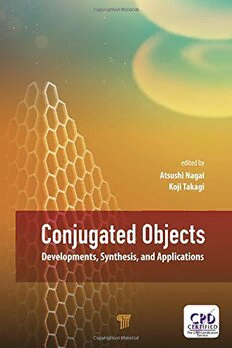
Conjugated Objects: Developments, Synthesis, and Applications PDF
Preview Conjugated Objects: Developments, Synthesis, and Applications
Conjugated Objects Pan Stanford Series on Renewable Energy — Volume 2 Conjugated Objects Developments, Synthesis, and Applications edited by editors Atsushi Nagai Preben Maegaard Anna Krenz Koji Takagi Wolfgang Palz The Rise of Modern Wind Energy Wind Power for the World Published by Pan Stanford Publishing Pte. Ltd. Penthouse Level, Suntec Tower 3 8 Temasek Boulevard Singapore 038988 Email: [email protected] Web: www.panstanford.com British Library Cataloguing-in-Publication Data A catalogue record for this book is available from the British Library. Conjugated Objects: Developments, Synthesis, and Applications All rights reserved. This book, or parts thereof, may not be reproduced in any form Copyright © 2017 by Pan Stanford Publishing Pte. Ltd. or by any means, electronic or mechanical, including photocopying, recording or any information storage and retrieval system now known or to be invented, without written permission from the publisher. For photocopying of material in this volume, please pay a copying fee through the Copyright Clearance Center, Inc., 222 Rosewood Drive, Danvers, MA 01923, USA. In this case permission to photocopy is not required from the publisher. ISBN 978-981-4774-03-1 (Hardcover) ISBN 978-1-315-22962-1 (eBook) Printed in the USA Contents Preface 1. Un ique Electronic and Stereochemical Properties xv of Salen Complexes 1 Takuya Kurahashi 1.1 Introduction 1 1.1.1 Syntheses of Salen Complexes 1 1.1.2 Salen Complex as an Asymmetric Catalyst 3 1.1.3 Role of a Redox-Active Salen Ligand in Catalysis 4 1.1.4 Building Block for Multimetallic Systems 5 1.2 Electronic and Stereochemical Properties Revealed by Experimental Studies 6 1.2.1 Role of Axial Ligands in Stereochemical Properties 6 1.2.2 Characterization of Salen Ligand Radicals 11 1.2.3 Localized versus Delocalized Salen Ligand Radicals 17 1.2.4 Stable Salen Ligand Radical with Cobalt 20 2. 1Fu.3s ed PoCloyncyclculisci oAnrosm atic Compounds: [n]Acenes, 21 [n]Helicenes, and Their Heterocyclic Analogues 25 Koji Nakano n 2.1 Introduction 26 2.2 [ ]Acenes n 28 2.2.1 Introduction 28 2.2.2 Hydrocarbon [ ]Acenes 29 2.2.3 Hneteroacenes 32 2n.2.4 Semiconducting Properties of [ ]Acenes and Heteroacenes 40 2.3 [ ]Helicenes n 42 2.3.1 Introduction 42 2.3.2 Hydrocarbon [ ]Helicenes 43 vi Contents 2.3.3 Heterohelicenes 48 2.4 Synthesis of Heteroacenes and Heterohelicenes via Ring Construction by Carbon−Heteroatom Bond Formation 51 2.4.1 Introduction 51 2.4.2 Heteroacene Synthesis via Ring Construction Including Carbon− Heteroatom Bond Formation 52 2.4.3 Heterohelicene Synthesis via Ring Construction Including Carbon– Heteroatom Bond Formation 56 3. 2Po.5ly (ortChoon-Pchluesniyolnesn e)s and Their Derivatives: 58 Synthesis, Conformation, and Physical Properties 67 Koichiro Mikami ortho 3.1 Introduction 68 3.2 Synthesis of Oligo-/Poly( -Phenylene)s 69 3.2.1 Stepwise Synthesis through Transition Metal–Mediated Reactions 69 3.2.2 Polymerization by Homocoupling Reactions 70 3.2.3 Polymer Reactions 71 3.2.4 Direct Polymeroirztahtoion of Aromatic Components 72 3.3 Conformationo orft hPooly( -Phenylene)s 74 3.3.1 Open and Closed Helix Models 74 3.3.2 Oligo( -Phenylene)s with Disubsotritthuoted Side Chains on Monomer Units 75 3.3.3 Oligo( -Phenylene)s with and without Monosubstituted Side Chains ortohno Monomer Units 77 3.4 Physical Properties and Applications of Poly( -Phenylene)s 80 3.4.1 As a Surface Modifier for π-Conjugated ortDhiosks 80 3.5 Poly(Quinoxaline-2,3-Diyl)s: “Cousin” of Poly( -Phenylene)s 81 3.5.1 Synthesis of Poly(Quinoxaline-2,3-Diyl)s 81 Contents vii 3.5.2 Conformation of Poly(Quinoxaline-2,3-Diyl)s 82 3.5.3 Circular Polarized Luminescence and Reflection 83 3.5.4 Chiral Catalysts for Asymmetric Reactions 84 4. 3El.e6c trocChoenmcilsutsryio onfs C aonndju Oguattleodo Pko lymers: Synthesis, 85 Properties, and Reactions 91 Shinsuke Inagi 4.1 Introd uction 91 4.2 Electrochemical Polymerization 93 4.2.1 Electro-Oxidative Polymerization of Aromatic Monomers 93 4.2.2 Method of Electrochemical Polymerization 94 4.2.3 Conditions for Electrochemical Polymerization 96 4.2.4 Electrochemical Doping 96 4.2.5 Electroreductive Polymerization of Aromatic Monomers 97 4.2.6 Copolymer Synthesis by Electrochemical Methods 98 4.2.7 Application of Conducting Polymers 98 p 4.3 El.ectrochemical Postfunctionalization of -Conjugated Polymers 99 43.1 Anodic Substitution Reaction of Conducting Polymers 99 4.3.2 Cathodic Reaction and Paired Reactions 104 4.3.3 The CRS Method 106 5. 4Ch.4a in-GCroowncthlu Psoiolynms erization for the Synthesis of 107 π-Conjugated Polymers 113 Yoshihiro Ohta and Tsutomu Yokozawa 5.1 Introduction 113 5.2 Kumada–Tamao Coupling Polymerization 115 5.2.1 Mechanism 115 5.2.2 Initiators 117 viii Contents 5.2.3 Ligands of Catalysts 119 5.2.4 Monomers 120 5.3 Suzuki–Miyaura Coupling Polymerization 127 5.4 Other Methods 130 6. 5Sy.5n thesCiso onfc Pluoslyiothniso phene-Based Architectural 133 Macromolecules: Recent Progress in Controlled Polymerization 139 Tomoya Higashihara 6.1 Introduction 140 6.2 Polythiophene 141 6.3 Regioregularity 142 6.4 Controlled Synthesis of Polythiophene 144 6.5 Chain-End-Functional Polythiophene 146 6.6 All-Conjugated Block Copolymers 150 6.7 Semiconjugated Block Copolymers 154 6.8 Conjugated Branched Polymers 157 7. 6Th.9r oughC-oSpnacclues-Cioonnsj ugated Compounds 116711 Yasuhiro Morisaki 7.1 Introduction 172 7.2 Synthesis of [2.2]Metacyclophane-Based Through-Space-Conjugated Compounds 173 7.3 Synthesis of [2.2]Paracyclophane-Based Through-Space-Conjugated Polymers 174 7.4 [2.2]Paracyclophane-Based Conjugated Oligomers for Understanding Through-Space Conjugation 176 7.5 [2.2]Paracyclophane-Based Through-Space- Conjugated Polymers for Energy Transfer 179 7.6 [2.2]Paracyclophane-Based Through-Space- Conjugated Oligomers for Unidpiraercational Energy Torratnhosfer 182 7.7 Conjugation Length of Pseudo- - and Pseudo- -Disubstituted [2.2]Paracyclophanes 185 7.8 Conclusions 187 Contents ix 8. Synthesis, Structures, and Functions of Helical π-Conjugated Polymers 193 Hiromitsu Sogawa, Kazuko Nakazono, and Toshikazu Takata 8.1 Introduction 193 8.2 Polymerization Catalysts and Configurations of Substituted Acetylenes 194 p 8.3 Dynamic Secondary Structures of p -Conjugated Polyacetylenes 197 p 8.4 Foldamer-Type -Conjugated Helical Polymers 203 8.5 Application of -Conjugated Helical Polymers 209 9. 8Co.6n trol Coof nSeclluf-sAisosnesm bling Behavior of Organic 213 Polymers via Charge Transfer (CT) Interaction of π-Conjugated Planes 223 Kenta Kokado 9.1 Introd uction 224 9.2 Linea r Polymers Linked by CT Interaction 225 9.2.1 Porphyrin-Based Linear Polymers 226 9.2.2 TTF-Based Linear Polymers 228 9.2.3 Host-Stabilized CT-Based Linear Polymers 231 9.3 Contr ol of Secondary Structure of Polymeric Chains via CT Interaction 234 9.3.1 Folding Copolymer System with Alternating Donor and Acceptor Units 235 9.3.2 Folding Homopolymer System Affected by External Molecules 239 10. 9Li.q4u id CCryosntacllulinsieo Mnsa terials in Mesoscopic Scale 224563 Tomomichi Itoh 10.1 Introdu ction 253 10.2 What Is a Liquid Crystal? 254 10.2.1 Director Vector and Orientational Order of LC Molecules 254 10.3 LC Molecules 256 10.3.1 Molecular Structure of a Liquid Crystal 256
